Heat Pumps, Hooray!
TL;DR: We built a heat pump calculator that helps you understand the benefits of a heat pump for your specific home. Heat pumps are a highly efficient, climate-friendly option for heating and cooling your home.
The year is 2022...
...and 60% of homes in the US are heated by piping flammable gas or oil into homes, lighting it on fire, and moving air over it.
The status quo hasn't changed since the '50s.
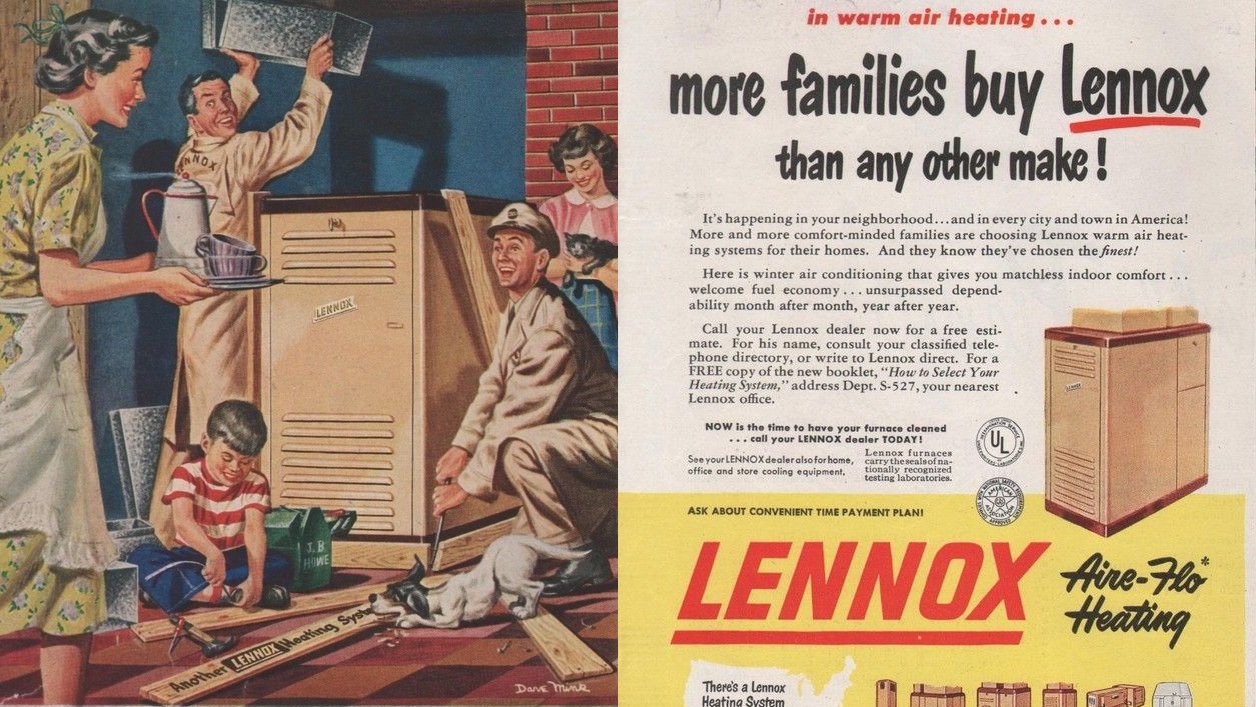
This ad comes from the 1950s. But the furnace in your home is nearly identical!
Isn't that odd, have we really not figured out something better?
It turns out we're not waiting on some technological breakthrough to modernize heating and cooling. It's here, and it looks like this...
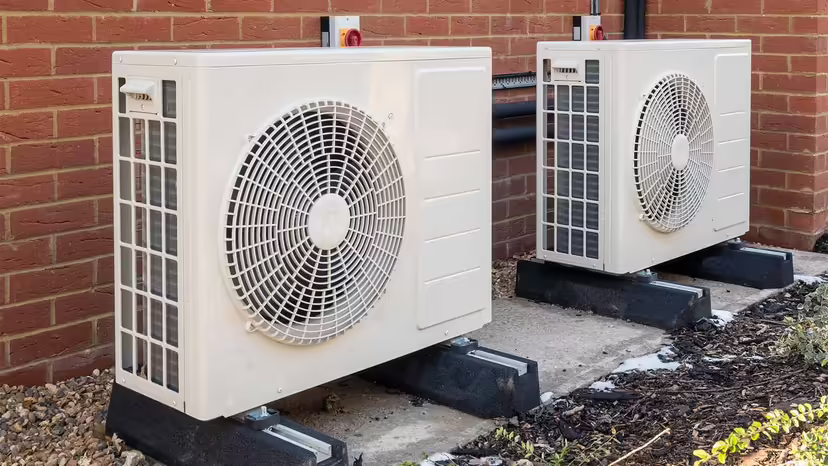
Behold: the space-age, 400% efficient technology known as a 'Heat Pump'
These nondescript devices are called heat pumps.
Heat pumps are a high-efficiency, low-emissions option for heating and cooling homes. They are more comfortable, cheaper, and more environmentally friendly than a traditional furnace and AC combo.
According to our analysis, 93% of single family homes in the US would save money with a heat pump compared to their existing equipment. If all homes switched to heat pumps, US homeowners would save $24 billion dollars per year on utility bills and reduce annual emissions by 152 million tons of CO2.
Switching to a heat pump is one of the few individual actions you can take to drastically reduce your climate impact. With one decision, the median homeowner will save 30 tons of CO2 emissions over the next 15 years -- thats equal to twice their entire annual footprint.
We looked long and hard for a way to understand the impact of getting a heat pump. We couldn't find one, so we built this guide. We wanted to create a tool that is simple enough for a typical homeowner to understand, but detailed enough for an HVAC technician to believe.
Want to figure out what a heat pump could mean for your home? Read on...
How does a heat pump work?
TL;DR: Heat Pumps work like an AC Unit, but they can also run in reverse to heat your home using only electricity.

They do this by quite literally pumping heat into the home (to warm it) or out of the home (to cool it).
Want to dig deeper? Good, us too :)
Mechanically, heat pumps consist of several parts...
Refrigerant: Refrigerant is a substance with a very low boiling point (-40°F) that is used to tranport heat between the inside and outside of the home. The most common refrigerant today is R-410A, but many working fluids will do.
An outdoor unit: This sits outside your home and blows air over an outdoor metal coil that is filled with refrigerant. The outdoor unit also has a compressor (see below). Outdoor units somtimes look identical to an outdoor AC unit, and other times they're more boxy, like this one:

This outdoor unit in NYC is doing what it does best: cooling your home
An indoor unit: This sits inside your home. It contains a coil to release or absorb heat. It can sit where your furnace is today, or can be wall-, ceiling-, or floor-mounted, known as ductless or 'mini-split'.
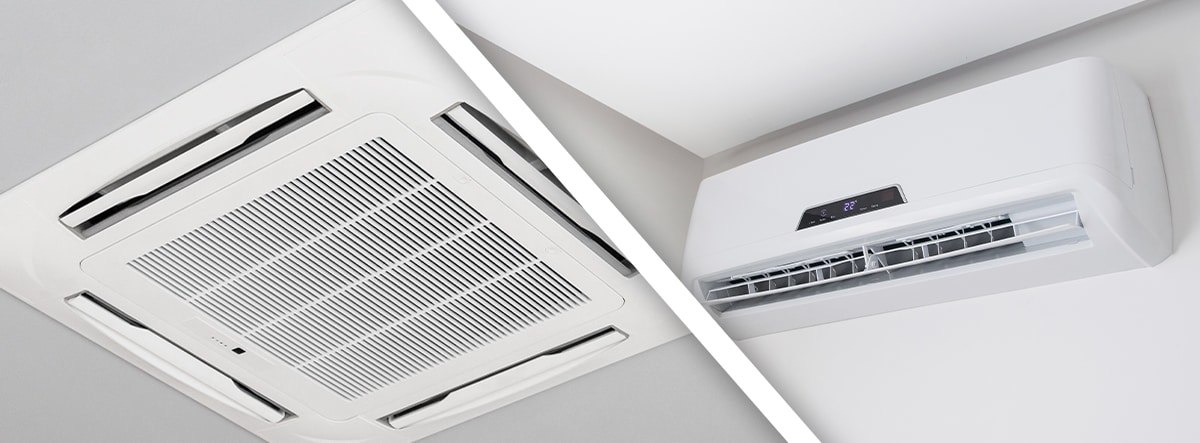
Indoor units come in many different form factors. Some can be hidden within walls or behind existing vents, some sit on your wall, and some just sit where your furnace is today. via eComfort
A compressor: A compressor takes refrigerant and compresses it into a high-temperature gas to help heat your home. Modern heat pumps are more efficient than AC units in part because they contain variable-capacity compressors rather than just a compressor which runs "on" or "off".
A reversing valve: In heating mode, heat energy is pulled from the outside into the home. In cooling mode, the exact opposite happens. This is controlled by the reversing valve. When you switch your thermostat from 'heat' to 'cool', the reversing valve is switched!
An expansion valve: In order to allow the refrigerant to change from a liquid to a gas, an expansion valve lets liquid into a lower pressure section of the system, where it can more easily undergo a phase change (see below) to gas by absorbing heat.
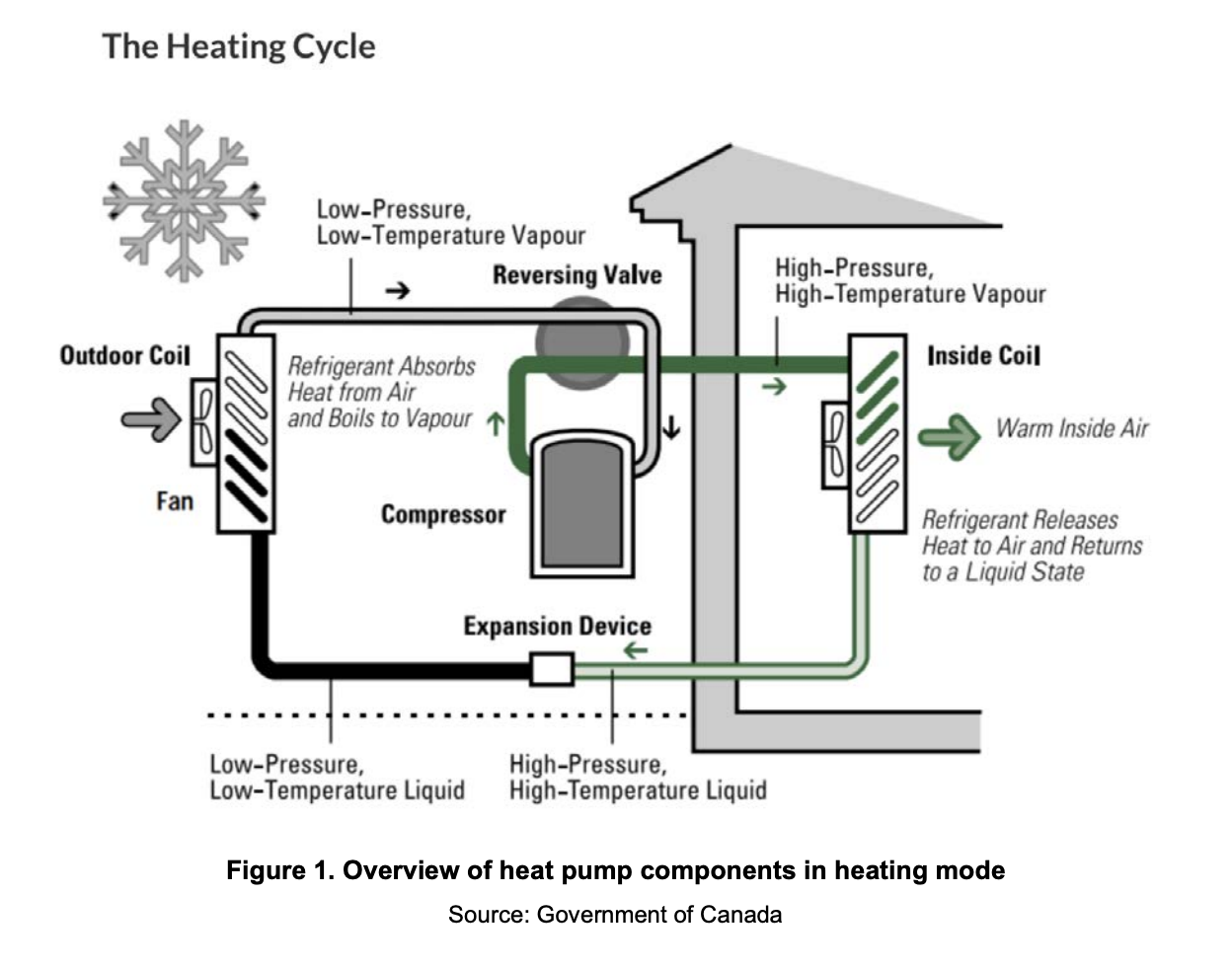
Here's the heat pump heating cycle. All the components are working together to move heat inside the house. via NREL
While the high-level operation can make sense, it's a little hard to wrap your head around the idea of heat pumps without scratching a layer below the surface.
To understand that, we need two basic concepts from high school physics: heat and phase changes.
Heat exists everywhere. The temperature in a substance is just a measure of the average kinetic energy of the particles. Heat is always trying to move from a hotter place to a cooler place (aka entropy or the second law of thermodynamics!).

When heating, heat pumps take advantage of entropy by making the outdoor unit colder than the ambient air temperature. As they do, heat naturally flows from the air to the coil of refrigerant.
Phase changes occur when a substance moves from a liquid to a gas (evaporates). During this process, it will absorb heat from its surroundings.
This is what happens when you boil water. Heat from the range is absorbed, causing the water molecules to move more quickly and become a gas.
When a gas becomes a liquid, the opposite reaction happens. Heat leaves the gas to the surrounding area and the molecules slow their kinetic energy.
When you breathe on a window on a cold day, the vapor in your breath loses heat to to the outside, causing it to condense!
If you're really ready to nerd-out, here's what the pressure enthalpy diagram looks like.
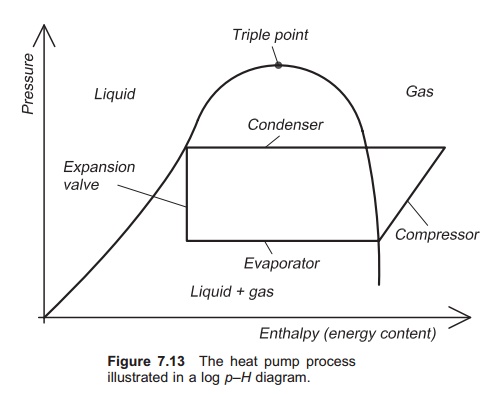
Here's the phase change and pressure diagram. To heat your home, the heat pump moves around the trapezoid in a counter-clockwise motion. via BrainKart
Heat pumps exploit these two principles by pumping refrigerant around a closed loop. When the refrigerant transitions from a liquid to a gas, it pulls in heat from the surrounding air. When the refrigerant changes from a gas to a liquid, it releases heat.
Heat pumps work just like an AC unit, but thanks to the reversing valve, they can also heat your home.
For your home
Now that you know what a heat pump is, let's calculate the impact and cost savings for your specific home.
Heat Pump Calculator
Home info
Heating equipment
AC equipment
How did you get those numbers?
Determining the cost and carbon impact of a heat pump retrofit is far from trivial.
To learn more, expand the sections below...
Step 1: Heating and Cooling Loads
We first need to understand how much heating and cooling your home needs, referred to as its heating and cooling loads.
HVAC technicians use the Manual J procedure to do a version of this, and you should ask your contractor to do one when the time comes. For now, we can get similar results with the info you've entered into the calculator. (Want even more precise results for your home? Contact us)
We look hour by hour at the weather and these attributes to determine your heating and cooling needs.
The temperature inside your home measures how much heat energy the air contains, and that changes due to several factors:
Conduction: When there's a difference between the temperature outside and the temperature inside, heat energy enters or leaves the home through walls, windows, floors and ceilings, at speeds determined by your home's insulation.
Convection: Outside air also enters the home through cracks and leaks. High winds cause more outside air to enter the home through tiny openings around windows and doors, and relative humidity impacts how warm or cool that air feels.
Solar radiation: Cloud cover, combined with your home's orientation, windows, and the shading of nearby trees or buildings, determines how much additional energy is gained from direct sunlight.
Internal loads: Regardless of the weather outside, appliances like your oven, hot water in your pipes, and human beings in the home each create heat year-round.
These factors make intuitive sense. You have to pull the shades down in that west-facing room or else it turns into a greenhouse in the late afternoon... you feel drafts on a cold, windy day... your bedroom is warmer than the rest of the house when you wake up in the morning... the kitchen heats up as you're cooking dinner...
That adds up to the amount of heat energy, measured in BTUs per hour, that your equipment will need to add to or remove from your home in order to maintain your thermostat setting.
Let's look at the days last year when your home needed the most heating and cooling -- your peak loads:
If we zoom in, we can see the hours when your home needed the most heating and cooling:
Rather than size for the most extreme temperatures, the HVAC industry standard is to size your equipment based upon the 1% coldest days and 99% hottest days.
Why 1% and 99%? If you get a unit that is oversized, it will hurt your operating efficiency during the rest of the year. Even when the temperature dips below that 1% threshold, your home won't instantly 'go cold', it will just be a degree or two below your thermostat.
So, we applied the same technique over the last 30-year history. Here's the loads we found.
And voila! You now have the heating and cooling loads designed exactly for your exact home. If you fill in the 'advanced' settings, we can get even better load calculations.
Step 2: Choosing your ideal heat pump
Once we have your heating and cooling loads, we are able to filter down from the total universe of heat pumps out there to just the ones that work best for your home.
We analyze detailed performance information for more than 2,300 heat pumps in the NEEP Air-Source Heat Pump Database, the most comprehensive source of manufacturer ratings for heat pumps.
From there, we can filter for viable options. These are the units which match your ducting configuration, have enough capacity to meet your heating and cooling loads, and spend less than 50% of the time cycling between on and off modes.
Once we narrow our list of viable heat pumps, it's time to simulate against your actual home.
Modern day heat pumps can be much more efficient because they use an inverter. The inverter allows the compressor to run at 'half-power' rather than being fully on or fully off.
A heat pump running at a fraction of max capacity will have a much higher coefficient of performance (COP) and run much more efficiently.
That all led us to our top units. We ranked these by their COP to ensure that you're getting the best heat pump for your home on the market.
Here's the best models that we found.
The result is a top heat pump with a COP of 3.00! That's 3x better than a furnace or electrical heater.
Step 3a: Cost impact
The biggest question that most homeowners have is: "How much will a heat pump cost?"
There are two important types of cost to consider here: one-time costs for the hardware and installation, and ongoing monthly costs for the electricity.
We took these costs into account for both a heat pump and a dual furnace/AC setup.
Monthly Costs
To calculate monthly costs, we pulled from the EIA Datasets which list the average price of electricity by state.
We calculated the hour-by-hour heating and cooling load your home would need (BTUs/h). Then we determined the electrical power your ideal heat pump would need to function (kWh).
The heat pump's efficiency depends on a whole host of factors, including
- elevation (pumps at 6k feet operate at 80% capacity)
- temperature differential (we fill in the COP curve relative to manufacturer ratings in the NEEP database)
- capacity (high-capacity pumps will short-cycle, causing pumps to operate at low-efficiency)
Our model takes each of these into account.
One-time Costs
Installing a heat pump has a few one-time costs. You are guaranteed to pay for...
- the hardware of the unit ($1,500-3,000 per unit)
- the installation (typically about double the hardware)
Depending on your home, you might need to...
- install new larger ducts ($10,000-20,000). If you already have an AC, you won't need this.
- install a new electrical panel capable of 200A ($1,000-3,000). If you already have an EV or induction stove, you are already set.
- install 240V outlets. Most heat pumps can't run on the 120v outlets that the rest of your home uses
But there are also a few types of rebates which work in your favor...
- The Inflation Reduction Act has a $10,000 rebate for installing a heat pump.
- Local utilities often have their own rebates ($1,000-3,000).
When incorporating both of those costs, we looked over the entire lifetime of the unit. In most geographies, you get savings both in terms of annual costs, but also from only needing one unit vs two!
Step 4: Carbon impact
Picking a heat pump is a big decision because you make it once, and then your carbon impact lives on for the next 15 years of the unit's lifetime.
Calculating that individual impact is tricky and depends on your existing equipment.
Gas furnaces and boilers
A gas furnace or boiler contributes to global warming in two different ways...
- Leaking methane into the atmosphere: Recent data suggests that about 3-4% of methane simply leaks out of pipes in transit to your home. Older furnaces and boilers will also leak more methane themselves. Methane is a potent greenhouse gas, with approximately 25 times the warming effect of CO2.
- Burning methane in a combustion reaction to create CO2: We modeled the amount of fuel your furnace or boiler would need based on your homes hour by hour heating load and the equipment's AFUE rating or age. To calculate annual emissions, we used an EIA Dataset that lists emissions intensity for each fossil fuel source.
Modern gas furnaces can be up to 98% efficient (meaning they create 98 BTUs of heat for every 100 BTUs of gas they combust). Older furnaces may be only 50-60% efficient, meaning that they require (and leak) a lot more methane to heat a home.
Versus a Heat Pumps...
Because a heat pump is electrically powered, the emissions come from two places
- Grid emissions. Today, our grid doesn't produce exclusively clean power (though it is getting cleaner all the time!). At peak hours when the sun has set, today's grid is typically powered by burning natural gas, coal, or other non-renewables, grid composition is specific to where you live. To calculate the emissions for a heat pump, we used a dataset that measures grid emissions for each balancing authority (think: local grid) on an hourly basis.
- Refrigerants. Most heat pumps today use R-410A as their refrigerant. You can think of a refrigerant as just a substance which can easily move heat around by changing from liquid to gas. Unfortunately, R-410A also has global warming potential. We used a 2014 UK Report that estimated a 3.5% annual leak rate, as well as a 15% leakage at the time of decommissioning, to account for the possibility (though not inevitability) that refrigerants from a heat pump may end up in the atmosphere.
Get a heat pump
Ready to save fifteen years' worth of carbon emissions? Here's how to get a heat pump installed in your home in four easy steps.
Before starting the process of getting a heat pump, you'll want to answer the following questions:
1. Do you have AC? If you have AC and live in a warm climate, you can skip the rest of the questions. Heat pumps can most likely replace your AC units 1:1.
2. Do you live in an apartment complex? If you don't own your home, you'll probably to take a different route. We recommend Blocpower for buildings or Gradient for heat pump window units.
3. Do you have outdoor space? You'll need to put the outdoor unit of the heat pump somewhere outside. This could be on a roof, beside your house, or mounted on the wall. It just needs to be above the snow-line.
4. Do you have a large enough electric panel? You'll probably need a 200A panel to install a heat pump. If you already have an EV charger or induction cooktop, your panel is probably good-to-go. We recommend Span as a modern panel, a typical replacement costs around $500.
5. Do you have big enough ducts? Heat pumps heat air to a lower (but still hot) temperature vs a gas furnace, so they need to move more air to keep your home warm. If your home has small ducts, more common in cold climates, you can either upgrade them or install a duct-less heat pump. Replacing ductwork is a big task that may increase the price by $10,000-20,000.
Finally, if you haven't done so, we recommend upgrading your insulation. Sealed is a great company to do this.
We typically recommend you get quotes from three different contractors so you can compare them. A "full heat pump install" will cost anywhere from $4,000-20,000. You can find your full cost breakdown by filling out the calculator.
Our best advice is to ask friends and neighbors in your area. Like any other home improvement project, you'll want to find trusted local HVAC installers who have a lot of experience.
There are a number of startups who are also making this easier.
- Amply (New England)
- Dandelion (New England, ground-source heat pumps)
- Elephant Energy (Colorado)
- Gradient (single-room)
- Helio (Colorado)
- Lun (Europe)
- QuitCarbon (California)
- Sealed (New England, Wisconsin, Chicago)
- Blocpower (apartments)
If you live in a major city, there might be local groups that can help identify installers:
- Bayren (SF Bay Area)
- NYS Clean Heat (New York)
- Your local electric utility
Beyond that, there are the usual suspects to find contractors: Google, Yelp, and Thumbtack.
Once you have your quotes and choose your contractor, it's time for them to actually install your heat pump.
It might take a week to get on their schedule, but heat pumps can then be installed in under a day.
Most contractors will have more availability in the shoulder seasons (Spring/Fall), so those tend to be the best times to schedule for the fastest turnaround.
Chances are good that you can get $800-3,000 in rebates per heat pump. In some cases, even up to $10,000!
There are three places to look for rebates:
- Federal incentives: Look at Energy Star
- State/local incentives: Search your state or city + "heat pump rebate"
- Utility incentives: Your local utility (PG&E, ConEd, etc) wants you to use a heat pump too! they probably have hundreds of dollars available for installing one. Ask your contractor upfront if they participate in utility rebate programs, because they'll probably have to apply for these rebates on your behalf.
Additionally, DSIRE is a nationwide resource for finding local incentives. It's not totally comprehensive, so don't get discouraged if you don't find anything.
The Inflation Reduction Act also has a ton of provisions for rebates on heat pumps. It will give you a 30% tax credit up to $2,000, and rebates of up to $8,000 for households earning less than 150% of the local median income.
Check out Rewiring America's IRA savings calculator to see what's available to you. Some of the IRA incentives are available right now, others will become available in January 2023.
Rather have someone take care of all this for you? Enter your email.
FAQ
- You want to save money on your monthly energy bills.
- You don't have A/C, but want to stay cool in hotter summers.
- You want to make one decision that will meaningfully reduce your carbon footprint.
- You have solar or a battery and like the idea of living off-grid.
- You hate the idea of flammable gas leaking into your home.
In a word: yes.
Heat pumps have gotten the reputation that they don't work in cold climates. But advancements made over last 15 years have made that claim totally false!
Today's cold weather heat pumps are rated to operate efficiently down to 5°F and lower.
What happens below that temperature? A heat pump will keep working, but the efficiency will start to go down. You'll need more electricity to keep it's heat.
Homes in exceptionally cold climates (think -20°F) get around this by installing what's known as a "dual-fuel" setup. Homeowners can install backup resistance or gas heating which can consistently supply heat on the coldest days, while using heat pumps 99% of the time.
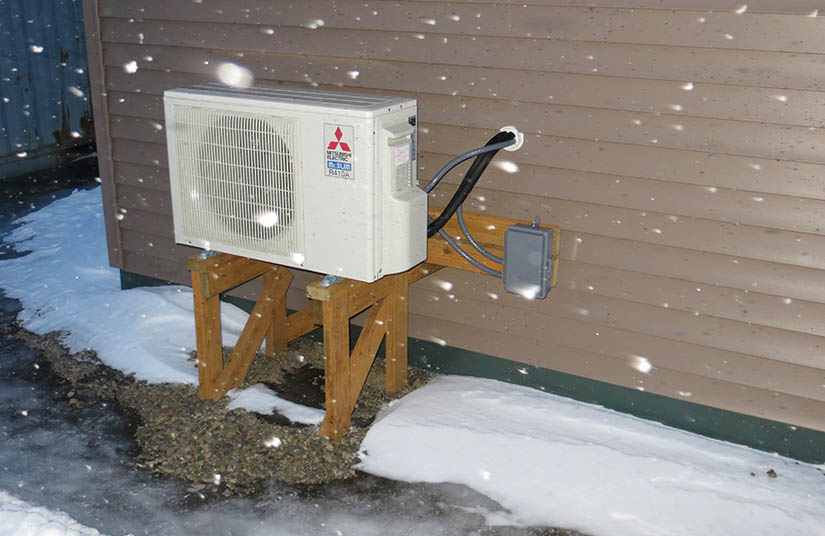
An air-source heat pump operating in snowy conditions. via NREL, courtesy of Tom Marsik
The tech continues to get even better. The DOE recently sponsored a prize to create a high-efficiency, cold-climate heat pump. The new heat pump by Lennox can maintain 100% heating at a COP of 2.0.
If you're curious, we also recommend the articles from Carbonswitch and Sealed.
Carbonswitch surveyed 125 heat pump owners and found a total install cost of $12-14k. We've seen the all-in cost fall anywhere from $8-20k, depending largely on where you live (which tends to correlate with technician familiarity with the conversion process, the configuration of the house, and availability of equipment).
The upfront cost of a heat pump will likely be higher than a furnace or A/C alone, but will end up saving you money because you'll no longer need two units.
Since furnaces, A/C units, and heat pumps all have a useful lifetime of around 15 years, you'll save money over that time horizon.
All the heat pumps we've discussed on this page are known as air-source heat pumps. They take heat from the air and move it around.
In some more extreme climates (e.g. the northeast), it makes sense to use what's known as a ground-source heat pump. A few hundred feet underground, the ambient temperature tends to remain a stable 45°F-75°F (depending on latitude).
In the northeast, the ground temperature is around 55°F all year round. This works particularly well because the winters are much colder than 55°F while the summers stay much hotter than 55°F. Heat can be pumped or pulled from undeground, nearly infinitely.
The one downside of a ground-source heat pump is that it requires a much bigger footprint: you have to drill holes and install them underground.
If you're interested in learning about ground-source heat pumps, we recommend you check out Dandelion Energy.
Heat pumps come in two flavors: ducted and ductless (also called mini-splits).
A ducted heat pump leverages your home's existing ducts to circulate air throughout your whole home. The advantage here is that you don't see the indoor unit at all. It sits near your air mover and blows air through the ducts to heat or cool your entire home.
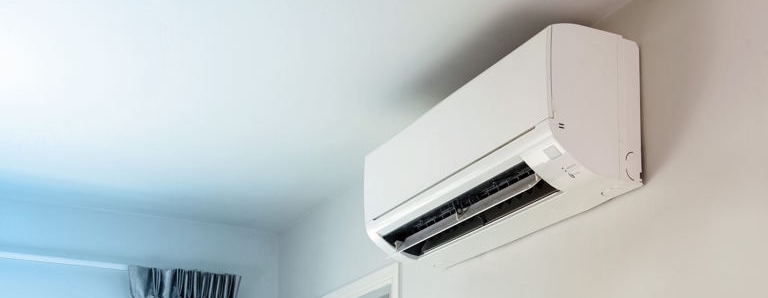
This "mini-split" indoor unit doesn't require any ducting. It just sits on your wall and pumps heat to the outdoor unit via refrigerant lines. (via mysa thermostats)
A ductless or mini-split heat pump consists of an indoor unit that typically sits on your wall. It doesn't require ducting, so you can install a mini-split in an area like a garage or ADU. The advantage of a mini-split that it doesn't require any ductwork at all, but it can only heat a single room.
You'll need the new heat pump of course, but there are a few other components that are important, and which could significantly impact the final cost of the upgrade:
1) Big enough ducts. Because a furnace outputs hotter air than a heat pump (think 130°F vs. 90°F), it requires less air circulation. The hotter the air is, the less of it you need in order to heat up a space. If you have an A/C system and live in a hot climate, your ducts are probably already large enough for a heat pump to heat and cool your home. If you don't have central A/C or live where the A/C runs rarely, you may have small ducts that need to be replaced. If you choose a ductless configuration (mini-splits), then you don't need to worry about ductwork.
2) A 100-200A panel. Your electrical panel controls the amount of current and power running to all of your electrical devices. If you are installing a heat pump in-place of a furnace, you may need extra electrical power. If you have a 200A panel already, you should be good to go. Older homes with 80A or 100A panels may require a panel upgrade to make room for the heat pumps. If you're planning to add solar or buy an electric vehicle, you'll almost certainly need to do this anyways. We recommend checking out Span.
3) 240V power outlets. You'll need adequate power being supplied to the indoor and outdoor heat pump units. If you already have central A/C, the most you should need is an additional 240V outlet where your furnaces currently are, inside the home. If that outlet is only necessary for backup electric resistive heating (coils/strips installed in the air mover), be sure to double check that you actually need it; modern cold-climate heat pumps may be able to maintain your thermostat setting even in the coldest hours for your home without it.
4) Outdoor or roof space. There has to be some place outside the home for the outdoor unit to be mounted. If you already have central A/C, the heat pumps will just take the place of those units. If not, luckily, many heat pump units take up less space than traditional A/Cs and can be mounted off the ground.
It probably goes without saying, but if you live in an older home, perhaps the biggest thing you can do to improve your efficiency is to weatherize your home by upgrading insulation and sealing leaks. We recommend checking out Sealed to help with insulation.
Heat pumps can be installed in less than a day. The end-to-end process will probably take about two weeks with sizing and coordination.
If your electrical panel or ductwork needs upgrading, it could take longer. It's best to replace old equipment while it's still working, instead of waiting for it to break (which typically happens during the hottest and coldest days!).
Our first advice is to ask friends and neighbors in your area. Like any other home improvement project, you'll want to find trusted local HVAC installers who have a lot of experience.
There are a number of startups emerging who are also making this easier.
- Amply (New England)
- Dandelion (New England, ground-source heat pumps)
- Elephant Energy (Colorado)
- Gradient (single-room)
- Helio (Colorado)
- Lun (Europe)
- QuitCarbon (California)
- Sealed (New England, Wisconsin, Chicago)
- Blocpower (apartments)
- Harvest Thermal provides smart radiant heating
If you live in a major geo, there might be local aggregators that can help identify installers:
- Bayren (SF Bay Area)
- NYS Clean Heat (New York)
Beyond that, there are the usual suspects to find contractors: Google, Yelp, and Thumbtack.
Chances are good that you can get $800-3,000 in rebates per heat pump. In some cases, even up to $10,000!
There are three places to look for rebates:
- federal incentives: look at Energy Star
- state/local incentives: search your state or city + "heat pump rebate"
- utility incentives: your local utility (PG&E, ConEd, etc) wants you to use a heat pump too! they probably have hundreds of dollars available for installing one.
Additionally, DSIRE is a nationwide resource for finding local incentives. It's not totally comprehensive though, so don't get discouraged if you don't find anything.
The IRA has a ton of provisions for rebates on heat pumps. It will give you a 30% tax credit up to $2,000, and rebates of up to $8,000 for households earning less than 150% of the local median income.
Check out Rewiring America's IRA savings calculator to see what's available to you. Some of the IRA incentives are available right now, others will become available in January 2023.
Weird right? We have a well-established, clean piece of technology. And yet, it’s only deployed in 10% of homes. There’s a bunch of reasons for that. Our big three...
- Homeowners just don't know. (hence, this site 🙂)
- HVAC installers don't recommend them because it's easier to replace what's already there.
- The tech has come a long ways in the last two decades, but the marketing hasn't kept up.
If we have any shot at reversing climate change, we'll have to eliminate the 5% of emissions going to home heating and cooling. In order to meet our climate goals, every household in america will need a heat pump going forward.
Glad you asked. Heat pumps work by using refrigerants. You can think of a refrigerant as a substance with an extremely low boiling point (-40°F).
Because the boiling point is so low, the refrigerant can phase change between liquid and gas, moving heat around with it (good!). Because the boiling point is so low, refrigerants can escape and vaporize into the atmosphere, causing additional global warming (bad!).
Today, the current standard refrigerant is a substance known as R-410A. It's moderately better than previous refrigerants, but still has a lot of global warming potential (GWP). There's talk of banning R-410A by 2025, though it hasn't yet fully materialized.
If you're wondering, yes, we did incorporate refrigerant emissions into our models.
We used a 2014 UK Report that estimated a 3.5% annual leak rate, as well as a 15% leakage at the time of decommissioning, to account for the possibility (though not inevitability) that refrigerants from a heat pump may end up in the atmosphere. That way we get an apples-to-apples comparison.
Because today's refrigerants have such a big climate impact, new heat pumps will need to work with new refrigerants.
There are two types of new refrigerants...
- flammable (Propane, Isobutane): these behave more like R-410A, but they are, well, flammable (or semi-flammable). Using them would require updating building codes in a bunch of states. It's not insurmountable -- after all, we pipe natural gas into our homes and that's quite flammable -- but it is a barrier.
- higher-pressure (CO2): these refrigerants are not flammable but can only work at high pressures. Using them will require new compressor designs.
We don't have solid answers for either just quite yet, but most big HVAC manufacturers are doing research on new refrigerants.
About
We're Baker and Calvin. Nice to meet you.
When we first learned about heat pumps, we found it really, really hard to find up-to-date materials on them. And it was hard to understand what the impact would be for our specific homes. We put together this page as an honest assessment around the tech.
We've spent about 3 months putting together these models, testing them with friends and experts, and ensuring that we delivered something that makes sense.
If you end up installing a heat pump or found this page valuable, please get in touch! We love emails.